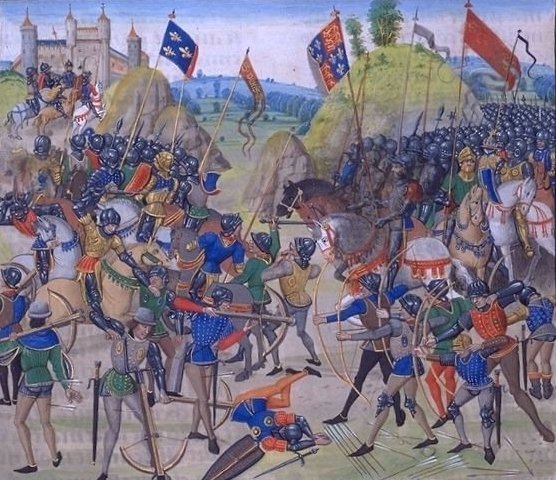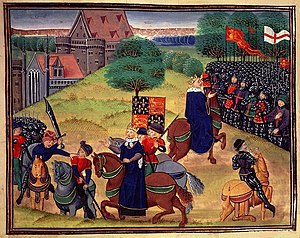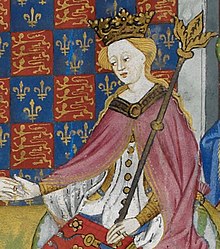.jpg/220px-King_Henry_VI_from_NPG_(2).jpg)
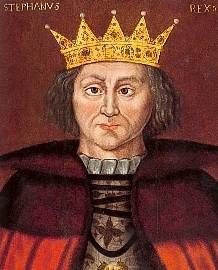
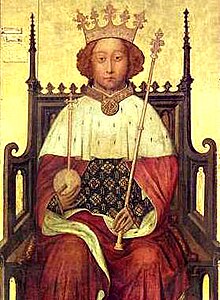
Above:
Henry VI (reigned 1422-1470), Stephen (reigned 1135-1154), Richard II (reigned 1377-1399)
The last few weeks, reading studies on late medieval English monarchs roughly in the period after the Norman Conquest up until the fifteenth century, have left me grappling with the fascinating and highly debated issue: who was England's worst medieval king? This article will look at arguably the prime contenders for this dubious title in the period 1066-1483.
Of course, not all English kings will be considered here, since the likes of Henry II, Edward III and Henry V are widely recognised to have been comparatively successful monarchs in medieval England. The prime contenders will each be discussed in turn, beginning with William Rufus.
William Rufus (c.1060-1100), reigned 1087-1000
William Rufus, also known as William II of England, reigned for thirteen years in the period 1087-1100, following the death of his highly successful father William the Conqueror. The third son of William the Conqueror and Matilda of Flanders, William Rufus can arguably be considered one of, if not England's worst, medieval king, because of his unfavourable temperament, his dubious policies and his notorious reign. Described by the
Anglo-Saxon Chronicle as 'hateful to almost all his people and odious to God', his struggles with the Church in his reign would make him notorious amongst contemporary chroniclers.
William never married, and as the third son of King William could never realistically have hoped to attain the throne of England. However, circumstances dramatically changed this in 1067 following the death of his father. At the age of about 27, William sailed to England from Tonques and was crowned in September 1087. He was described by William of Malmesbury as being 'well set, his complexion florid, his hair yellow; of open countenance; different coloured eyes; varying with certain glittering specks; of astonishing strength, though not tall, and his belly rather projecting'. Frank Barlow describes him on the Oxford Dictionary of National Biography as being at the time of his accession 'a seasoned soldier and commander but with only a limited knowledge of England, and, although well acquainted with his father's ways, without experience of government'. William's reign was unstable the moment he commenced it, most notably in 1088 with the rebellion of the nobles who supported his elder brother Robert, the ruler of Normandy, in favour of uniting England and Normandy. Hostilities lasted up to six months. Luckily, Rufus' appeals to the English people and his attack of the rebels personally, taking Rochester Castle, allowed his success. Barlow rates Rufus' reaction to the rebellion 'shrewd'.
Notwithstanding this, the historian H.W.C. Davis of Oxford University, in his book
England Under the Normans and Angevins 1066-1272, first published in 1905, is dismissive of Rufus, characterising him as 'so illiterate that he could not spell his way through an ordinary letter', he 'fought and squandered, leaving extortion to his clerks and judges'; he 'mounted the throne with little preparation and less fitness for that high position', criticising his policies towards the Church and his foreign policy during his reign. Certainly Rufus' long-standing conflict with Anselm of Canterbury made him notorious in a highly religious age, intensified when the archbishop went into exile in 1097. His failure to marry and sire a son, something expected of all kings in the medieval period, further gives impetus to the notion that he was something of a failure. The fact that Rufus faced continuous rebellions throughout his reign, including one from the Scottish King in 1091, further weakened his authority. Famous for his hot temper, monastic writers condemned his immorality, and there were even suggestions of homosexual behaviour, according to Barlow. This is strengthened, of course, by his failure to marry and sire an heir. His contentious relations with his brother Robert were not particularly helpful to his cause, although understandable in context. Killed in a hunting expedition in 1100, medieval commentators believed that Rufus' death was the act of a vengeful God against this blasphemer. Yet Barlow dismisses the notion that he could be seen as England's worst medieval king, writing: 'he had maintained good order and satisfactory justice in England and restored good peace to Normandy. He had extended Anglo-Norman rule in Wales, brought Scotland firmly under his lordship, recovered Maine, and kept up the pressure on the Vexin', suggesting that Rufus was 'a hero', even if he was lustful and 'a scandalous figure'.
Stephen (1092/6-1154), reigned 1135-1154.
Davis seems to rate King Stephen the worst medieval king in England's history, closing his account of Stephen's reign with the passage: 'Stephen did not die too soon... Too simple to anticipate intrigues, too scrupulous to destroy the root from which they sprang, too vacillating to crush them when they began to take effect, he failed alike in peace and war. Among all our medieval sovereigns none owed his title in so real a sense to the election of the nation; few showed themselves more incapable;
none was a greater curse to the nation... his reign furnished a warning...' Are these claims fair, suggesting as they do that Stephen was England's worst medieval king?
Born in c1092/6, Stephen was a grandson of William the Conqueror and thus kinsman to William Rufus, the son of Stephen II Count of Blois and his wife Adela of Normandy. A powerful landholder in French provinces, Stephen married Matilda of Boulogne through the efforts of the English king Henry I in 1125, and thus became even more influential in northern Europe. Edmund King suggests that this marriage 'moved him to the centre of Anglo-Norman political life'. Henry I seems to have regarded Stephen, who was his nephew, as his successor at this time, but following the death of Henry's daughter Matilda's husband in 1125, the situation changed, and in 1127, having returned to England, Matilda was declared heir to the English throne. In 1135 the English king died, setting in place the events which would eventually lead to Stephen's succession. Davis, in a somewhat misogynistic fashion, claims that Stephen became king because 'on the death of Henry I there was hardly a man in his dominion who desired the accession of the Empress [Matilda]. Her sex, the arrogance of her temper, above all her Angevin marriage, were objections which in most minds overrode all scruples as to oaths and pledges'.
Stephen immediately came to England, and was received by the citizens as king, probably because of his comparative popularity in English society at this time. He was seen as being modest, easy-going, and gentle. Henry's death occurred at a difficult time: his daughter Matilda and her husband Geoffrey of Anjou were in Anjou, involved in a rebellion against the royal army, while Stephen's elder brother Theobald - who arguably had a better claim to the throne - was further away, in Blois. Yet like Rufus' reign, Stephen suffered a succession of rebellions during the early years of his reign which severely threatened his authority, notably from the Welsh in the 1130s. Matilda's husband Geoffrey also periodically invaded in this period, and many saw Matilda as the rightful ruler of England. Compounding this, the complex relations with the Church caused discontent, particularly when Stephen seized the lands of the dead Archbishop of Canterbury in 1136. Barons increasingly opposed the king, feeling that they had not been aptly rewarded for their loyalty. Foreign policy further threatened Stephen in this years.
The situation took a turn for the worse in 1139, when civil war in England occurred. Empress Matilda was invited by Henry I's consort Adeliza to stay with her at Arundel, and in September the former Empress and her half-brother Robert invaded England. Robert marched north, hoping to obtain support for their rebellion. But Stephen besieged Arundel, entrapping Matilda, showing a fierce determination to preserve his crown. The complex events of this years are difficult to explain in detail. But civil war severely undermined Stephen's kingship. In 1140, Stephen faced further revolts from former loyalists, such as Nigel bishop of Ely, who had become disaffected with Stephen's rule. The king, later captured by Robert, was imprisoned in Bristol Castle, and Matilda was proclaimed Lady of the English - in effect, England's first ruling female. However, the Londoners refused to crown Matilda, viewing her as haughty, and she was forced to flee to Oxford, thus offering some hope for Stephen. Stephen's queen, confusingly also named Matilda, played a central role in these events, generating sympathy for Stephen's cause. Stephen was eventually released following the Angevin defeat at Winchester. A stalemate occurred in the period 1143-1146, although Stephen faced further rebellions from dissatisfied barons such as from the Earl of Essex. By 1147 England had suffered severely from the 'Anarchy', and it was believed to be in a state of chaos and destruction. The
Anglo-Saxon Chronicle wrote that 'there was nothing but disturbance and wickedness and robbery'. Yet the death of Robert that year, and Matilda's flight the following year, changed the nature of the conflict. But Stephen's chaotic relations with the Church did not help matters, particularly conflict with the papacy.
The next few years saw Stephen maintaining peace with Matilda's son Henry, later Henry II, and he was later recognised as Stephen's heir following the death of his son Eustace. In 1154 Stephen died, and Henry II succeeded to the English throne. Edmund King depicts Stephen as a weak king, easily manipulated by his brother or wife, and Crouch has also been negative in relation to Stephen. Yet was he England's worst king? Arguably, yes - his reign was characterised by civil war, rebellions, dissatisfaction of the nobles, problems with the Church, and conflict-ridden foreign policy. Yet Stephen survived, and the throne passed in a peaceful manner to Henry following a series of truces. It remains to be seen whether Davis' critical assessment can be confirmed.
John (1166-1216), reigned 1199-1216.
Most famous for the Magna Carta (1215), John has a strong claim to being England's worst king. Historian Ralph Turner criticises his 'distasteful, even dangerous personality traits', which encompassed spitefulness, cruelty and pettiness. Famously, John has been presented as the arch villain in
Robin Hood, particularly the Disney film of the same name.
John was born in 1199 as the ninth child, and sixth son, of Henry II of England and his infamous queen consort Eleanor of Aquitaine. Described as being red-haired, around 5'5 tall, and with a 'powerful, barrel-chested body', John's early life was engulfed by the rebellions led by his elder brothers Henry, Geoffrey and Richard (later Richard I) against their ageing father Henry II, John became increasingly influential, for instance being granted the estates of the Duchy of Cornwall in 1175. Following the death of his brother King Richard in 1199, John acceded to the English throne aged 33, having been supported by most of both the English and the Norman nobility against a pretender Arthur of Brittany. In 1200 John married Isabella of Angouleme, abandoning his first wife Isabel countess of Gloucester. This meant that warfare in Normandy recommenced. Complex events in Europe encompass this period, characterised perhaps most profoundly by the loss of Normandy in the period 1202-04. John's mother Eleanor was threatened by Arthur's forces, but John's forces were successful at the battle of Mirebeau. Yet John's power was not secure following this victory. John's local allies were deserted in 1203, and the pope was not successful in aiding John's cause. Arthur was probably murdered by John that year in an attempt to quash the unrest engulfing Europe and threatening John's stability.
In England, John's financial measures were not popular. He levied scutage payments eleven times in his reign, a much greater amount in his comparatively shorter reign compared with preceding English monarchs. Enormous sums were often charged in relation to relief payments when estates and castles were inherited. A new tax on income and movable goods in 1207 may also have caused resentment, although it was successful for the king in raising £60,000. Inflationary pressure and bad harvests, however, may have contributed to an increasingly resentful atmosphere. John, notoriously, was deeply suspicious of the barons at the English court, and numerous barons were subjected to John's
malevolentia (royal ill-will), including William Marshal. William de Braose's wife and son were imprisoned by John following conflict between this baron and the king, and they eventually died. John was also criticised by chroniclers for being lustful and irreligious, heinous sins by the standards of the clerical writers. He had many mistresses and illegitimate children. Some even accused John of being an atheist.
All this was worsened by John's continental policy in the years 1204-14. A potential French invasion undermined England's security, worsened by increasing baronial unrest. John also became embroiled in a dispute with Pope Innocent III in 1205, leading notoriously to the king's excommunication, the worst penalty possibly levied by the papacy. This resulted from John's desire for John de Gray, bishop of Norwich, to be appointed Archbishop of Canterbury, but Reginald was favoured by the Canterbury Cathedral chapter. Stephen Langton was later made Archbishop, and John was furious, barring Langton from entering England and seizing the archbishopric's lands and papal possessions. Innocent, not surprisingly, placed an interdict on England in 1208. His anger intensified, John tried to punish Innocent personally and sought to create a conflict between the English clergy who supported him and those who favoured the pope. John was later excommunicated in 1209. A reconciliation finally occurred in 1213, but John's reputation must have suffered appallingly.
This was made worse by the barons' discontent; in 1212 there had even been a plot against the king. Following John's return from France in 1214, rebel barons in north and east England organised resistance to his rule, congregating at Northampton in May 1215 and renouncing their feudal ties to John, appointing Robert FitzWalter as their military leader in an entirely unprecedented action. This 'Army of God' shockingly marched on London, taking the capital as well as Lincoln and Exeter. John later met the rebel leaders at Runnymede in June, and a charter was later created, named
Magna Carta. This promised new political reform, curtailing the powers of the king, promising the protection of church rights, protection from illegal imprisonment, access to justice, limitations on scrutage and other feudal payments, and new taxation only with the consent of the barons. Pope Innocent, having been contacted by the king, dismissed this document as 'illegal and unjust', excommunicating the rebels. The First Barons' War occurred shortly afterwards, following the failure of the agreement, and the first move was the seizure of Rochester Castle. In November John retook it, and while John was initially successful, by the end of the summer the rebels had regained southeast England and parts of the north. Attacking eastwards from London to Cambridge in September 1216, John later travelled to Lincoln and King's Lynn, but later contracted dysentery there, which proved fatal. By this time John was seen to face a 'stalemate' and a possible defeat. His illness worsened, and he died in October.
While John was initially praised by medieval chroniclers, he was later criticised by later commentators. Kate Norgate, a Victorian historian, attacked 'his almost superhuman wickedness', although Whiggish scholars saw Magna Carta as essential in the economic and political progress of England during this period. Historians today suggest that John's vices and failures were wildly exaggerated by contemporaries, but agree that he was a failure. They recognise that he was hard-working and enjoyed notable successes, although Jim Bradbury suggests that modern historians are too lenient towards John. Thus, while it is not certain that John was England's
worst medieval king, his reign was certainly characterised by conflict and controversy, and it cannot be seen as a success in any sense of the word.
Edward II (1284-1327), reigned 1307-1327.
A recent popular history study of Edward II's notorious queen, infamously named the 'she-wolf of France', Isabella, suggests that Edward was 'a weak and vicious monarch'. Many probably see Edward II as England's worst ever king. Although he fathered five children by two children, he was widely rumoured to be bisexual or even homosexual, due to his notorious relationship with Piers Gaveston (later executed), although historians should remember that notions of alternative sexualities in the modern sense of the word only really came into being in the nineteenth century, not the fourteenth.
Edward was the fourth son and eleventh child of Edward I of England and his queen Eleanor of Castile. Following the death of his father in 1307, Edward acceded to the throne as king of England aged twenty-three, comparatively young for an English monarch. Edward recalled to court his friend Piers, who had been dismissed by Edward I due to the belief that he was not suitable company for Prince Edward, and he was made Earl of Cornwall soon after. Piers was also married to the king's niece Margaret of Gloucester, a clear sign of his favour towards the Gascon knight.
In 1308, Edward married Isabella of France, aged merely thirteen, and later demonised as a 'she-wolf' (other English queens, such as Aelgifu and Margaret of Anjou, also suffered this dubious epitaph). Renowned for her beauty, intelligence, and diplomatic and political competence, Isabella arrived in England at a time of increasing discontent between the king and the barons (similarly to John in a sense). Her husband was resented at court for the lavish influence and rewards he bestowed upon Piers, meaning that it is not surprising that hostile commentators interpreted this as signs of a homosexual relationship between the two. Some have suggested that Edward frequently neglected his young queen, perhaps provoking her hostility, and many historians have noted with sympathy her uncomfortable position as the wife of a king who indiscreetly favoured another man at court. These problems were compounded when Edward left Piers to serve as Regent of England in 1308 when he travelled to marry Isabella, and some barons in the Ordinances of 1311 insisted vocally that Piers be banished immediately from the kingdom, due to the troubles associated with his presence. Other concerns present in the Ordinances concerned fiscal reform, setbacks in the Anglo-Scottish war, and the king's personal incompetence. In 1312 the earl of Lancaster ordered Gaveston to be captured, and he was handed over to two Welshmen who promptly murdered him at Blacklow Hill. The king suffered profound grief over his favourite's execution, and he became increasingly fixated on revenge upon those who had instigated his friend's death. The earls of Lancaster, Warwick, Arundel and Hereford were later forced to seek Edward's pardon.
Whether or not Edward and Piers engaged in homosexual sex is unknown; chroniclers criticised the king's passion for 'wicked and forbidden sex' and saw the relationship as being 'excessive' and 'immoderate beyond measure'. The Meaux Chronicle later noted that the king 'took too much delight in sodomy'. Added together, this compellingly suggests that the two did have sexual relations. However, sodomy encompasses much broader sexual relations than merely homosexual sex, and so it's difficult to tell what was meant specifically. Both Edward and Piers had children in their marriages and some historians have suggested that the relationship between the two actually more closely resembled an 'adoptive brotherhood'. Anyway, King Edward's defeat in Scotland in 1314 further blackened his reputation, considered by contemporary historians to be the English's worst defeat since 1066. The increasing influence of the Despenser family at court provoked the hostility of the barons, and in 1321 Edward was forced to banish them due to increasing pressure from hostile earls at court. Yet the king's opponents came to be murdered in a bloodthirsty revenge enacted shortly afterwards, including the beheading of Lancaster in the king's presence.
In 1325, Queen Isabella returned to France following a disagreement between England and France over whether Edward should pay homage to the French king. She was able to escape the influential Despenser family and the king's families, whom she resented deeply - it's possible to regard her with sympathy, her position must have been almost impossible in these embarrassing years. Isabella declared that she would not return to England unless the Despensers were removed. Isabella fell in love with Roger Mortimer, earl of March, during her time in Paris and they decided to plot together to usurp the throne from Edward - hence the beginning of Isabella's notorious reputation as a 'she-wolf' and adulteress. Edward was betrayed by those formerly close to him, perhaps alienated by his policies, and in September 1326 his wife and her lover invaded England. The king and the Despensers were left isolated, and the king was forced to flee. Unable to rally an army, this proved Edward's downfall. The Despensers were captured and executed by a victorious Isabella. Isabella was condemned, however, by some as being bloodthirsty when she ordered Hugh Despenser the Younger to be hanged, drawn and quartered publicly. Edward, imprisoned at Kenilworth Castle, was charged in 1327 with incompetence, losing lands in Scotland, Gascony and Ireland, allowing the murder of nobles, the failure of government, and a host of other failures. Weeping, he agreed to abdicate, and his 14-year old son Edward III was proclaimed king, controlled by the queen and her lover. Later imprisoned in Berkeley Castle, Edward was almost certainly murdered here by Isabella and Roger's agent, some notorious sources claiming a red-hot poker was inserted into his anus (perhaps a parody of his love for sodomy?) Some suggest that he actually lived until at least 1330.
When all is said and done, there is a strong case for the claim that Edward II is England's worst medieval monarch. His reign was characterised by political favouritism, uncertainty at court, conflicting foreign policy, the alienation of his queen and her supporters, and ultimately, he was forced to abdicate and was murdered by orders of his own wife, thus damaging her reputation permanently. Whether Edward really was 'weak and vicious', he can be criticised for his ineffectual policies, which led to the alienation of courtiers and undermined England's security devastatingly.
Richard II (1367-1400), reigned 1377-1399.
I am currently in the midst of reading a book on Richard II, since there seems to be a current vogue for him at present, perhaps influenced by the showing of
The Hollow Crown on the BBC. Was Richard II England's worst king? He was certainly arrogant, suspicious, cruel, cold and ruthless towards his enemies, not stopping to murder his own relatives. Yet he was also glorious, intelligent, a lover of regal splendour and patronage, and he has continued to fascinate and perplex historians and the general public.
The son of the chivalrous and renowned 'Black Prince' Edward and his wife Joan of Kent, Richard was born in 1367, the grandson of the celebrated king Edward III. Tall, good-looking and intelligent, Richard succeeded to the English throne aged merely 10 years old, and it's well known that minority rules are often clouded by political unrest and uncertainty at court and within the kingdom. This case was no different. Widespread opposition to the king's influential uncle, John of Gaunt, characterised much of English politics during the early years of Richard's reign. The king's influential councillors Simon Burley and the Earl of Oxford gained increasing control of royal affairs, causing resentment within the court. Heavy poll taxes in the period 1377-81 weakened English security further, leading to the infamous Peasants' Revolt in 1381, in which the fourteen-year old king was forced to meet the rebels personally and promise them sanctions in an attempt to quash the revolt. Many high-placed governmental officials, including the archbishop of Canterbury and the Lord High Treasurer, were publicly beheaded. Following the revolt, Richard married Anne of Bohemia in 1382, and the two appear to have enjoyed close relations until Anne's death in 1394, although there was no issue from the marriage, which proved to be a momentous and unsettling issue for the king.
The war in France caused further problems at court, with councillors favouring one of two approaches: peace, or aggressive military endeavours. The king turned his attention to Scotland, leading an expedition in 1385, but nothing came of it, while a French invasion of England undoubtedly undermined any notion of England's stability in these years. Factional discontent intensified at court, leading the king's uncle Thomas of Woodstock, duke of Gloucester, the earl of Arundel and the earl of Warwick to bring an appeal of treason against the king's favourites in 1387, including Michael de la Pole, the mayor of London Nicholas Brembre and the Archbishop of York; these nobles known as 'The Appellants' in bringing charges of treason against the royal favourites. Joining forces with Henry earl of Derby (the king's cousin) and the earl of Nottingham, the king was forced to comply with the Appellants' demands, and the royal favourites were removed from power, mostly being executed. Yet the Appellants, as Nigel Saul makes clear, were not popular, and their rule eventually crumbled following failures in foreign policy and court politics. Richard gained increasing authority at court, and promised to restore stability which had not been present in England during his reign.
Following Anne's death, Richard married the 7-year old Isabella of France in 1396, thus strengthening Anglo-French relations. In 1397, what came to be known as the 'tyranny' of Richard II began. Gloucester, Warwick and Arundel were arrested and punished, with Arundel being put to death, Warwick imprisoned, and Gloucester, the king's own uncle, apparently smothered by the king's supporters at his castle of Plushey. New favourites rose to power, including John Beaufort (the king's relative), the earl of Rutland, Thomas le Despenser, and others. But the House of Lancaster, in the form of Henry of Derby, posed a new threat to Richard's weak authority. Henry was disinherited and banished from England following a dispute with the earl of Norfolk, who was also banished. Yet when Richard left in May 1399 for Ireland, Henry famously invaded England and later took the throne, deposing Richard. Richard is thought to have been starved to death, having been imprisoned in Pontefract Castle.
Richard had been widely praised in his youth for his beauty, intelligence, and his development of court culture. He was intelligent, well-read and vivacious. Yet in the latter part of his reign he was increasingly criticised for his perceived arrogance, cruelty, and desire to wreak vengeance upon his political enemies. Shakespeare's play has severely influenced our understanding of Richard, depicting him as cruel and irresponsible, deserving of his fate. Many academic historians have wondered if Richard was actually insane. Yet Nigel Saul is reasonably fair in his assessment of Richard, and recognises the king's real strengths despite his, at times, political incompetence, cruelty and arrogance. It does not seem that Richard, in comparison with Edward II, can be classified England's worst medieval king, but he had certainly lost the majority of his subjects' respect and devotion by the time of his deposition in 1399, meaning his rule, on the whole, cannot be judged a success.
Henry VI (1421-1471), reigned 1422-1461, 1470-1.
Helen E. Maurer, in her sympathetic study of Henry VI's notorious queen, Margaret of Anjou (see http://www.conorbyrnex.blogspot.co.uk/2013/03/margaret-of-anjou-she-wolf.html), dismissively wrote of Henry VI that he was perhaps 'the greatest disaster' England was ever to experience. Indeed, many would agree with her that Henry VI was, quite simply, a disaster; England's worst medieval king.
It's perhaps fair to note that it wasn't all Henry's own fault. The son of the renowned and glorious king Henry V and his consort Catherine of Valois, Henry became king of England nine months old, and we have seen that minority rule never works well. This, of course, did not allow for political stability at court, and the king's uncles John and Humphrey were resented for their overbearing rule and political influence. Nonetheless, in the late 1430s and early 1440s Henry assumed growing authority and power as he became older, and in 1445 a prosperous alliance with France was achieved with his marriage to the 15-year old princess Margaret of Anjou, although this was not universally popular among his subjects. However, the king's failure to produce an heir with his consort caused considerable concern in a politically unstable kingdom. In 1453, when the queen eventually gave birth to their son Edward, many disputed who the father was in view of this.
Henry is often dismissed by historians as being pious and kind, but an entirely unsuitable king. Perhaps this is an unfair assessment, but when the king fell mad, or at least insane, in 1453, it plunged the kingdom into chaos. At a time of increasing unpopular attitudes towards the monarchy, caused largely by the loss of all the lands won by the English in France by Henry V save Calais, a breakdown in law and order, corruption and favouritism at the English court, and a rebellion in 1450 led by 'Jack Cade', the duke of York, the king's relative, became increasingly prominent at court and challenged royal authority. At Christmas 1454, King Henry eventually recovered his senses, but the Wars of the Roses were to be brought about nonetheless in view of these problems. A violent struggle between the competing houses of Lancaster and York took place, the first battle of St Albans occurring in 1455, although York was later killed at Wakefield in 1460. With the king's own incompetence, Queen Margaret was widely believed to be the figurehead of the Lancastrian cause. He was later captured by Edward earl of March in 1465 and imprisoned in the Tower of London, who was now king. Yet Margaret, now exiled, was determined to reclaim what she saw as her rightful place as queen and wife to the king, and schemed with the French king to win her throne back. Affecting an alliance with her former enemy the earl of Warwick, it was agreed that her son by the king would marry the earl's daughter Anne Neville. Warwick returned to England, forcing King Edward into exile, and restored Henry in 1470. Yet his return lasted less than six months, and he was murdered probably on orders of the returned king Edward, in the Tower in May 1471, following the death of his heir Edward in battle previously, thus undermining the Lancastrian cause seemingly beyond repair.
While Henry has been seen by some as a martyr, a devout and pious king, his reign was a failure, in every sense of the word, ushering in the Wars of the Roses. He was incompetent, beset by factional conflict, utterly unable to control powerful nobles, and dominated by ruthless courtiers. His queen, who sought to preserve both their royal state and the legitimacy of their son, was condemned by contemporaries as being unwomanly and a 'she-wolf', despite the fact that she was acting in her husband's interests. Although Henry may not have been unlikeable personally, he has a fair claim to being England's worst medieval monarch for what his reign brought about.
Richard III (1452-1483), reigned 1483-1485.
I don't wish to be attacked by the Richard III Society here, but it would be nonsensical to write an article on England's worst medieval king without at least mentioning Richard III, for he was demonised in his lifetime up until the present day, and many would argue that he was, by far, England's worst medieval king.
The son of Richard duke of York (killed at Wakefield during the Wars in 1460) and his wife Cecily Neville, Richard was younger brother to the king Edward IV. Following that king's premature death in 1471, it is believed that, fearing hostile and cruel behaviour from his sister-in-law Queen Elizabeth Woodville and her family at court, who were believed to be hoping to exclude Richard utterly from power, Richard seized control of the new king, the 12-year old Edward V, and later his brother Richard of York, in an attempt to control the political situation in England at the time. Edward IV's supporters were quickly routed from power; his most famous supporter Hastings being beheaded in June 1483. Elizabeth, in fear and concern, quickly retreated from power, and sought sanctuary with her daughters.
Whether or not Richard was really as evil as Shakespeare made him out to be is unlikely, yet he certainly took advantage of the uncertain political and dynastic situation in England at the time. Whether or not the princes in the Tower, as they later became known, were murdered on his own orders is impossible to ever know the answer to, but on a balance of probabilities, it seems the likeliest scenario - they were last seen in the autumn of 1483, and no attempt was made by the king to produce them publicly to counter persistent rumours alleged that he had ordered their deaths. Richard faced numerous rebellions during his short-lived reign, most famously from his former supporter Buckingham in November 1483, resulting in Buckingham's execution. Queen Elizabeth quickly sought an alliance with the Lancastrian Margaret Beaufort, agreeing that her daughter Elizabeth of York would marry Margaret's son Henry Tudor if he managed to wrestle the throne from Richard, seen by many as an unlawful usurper. In view of this, Richard's own dynastic situation must have troubled him severely. His son died in 1484, and it was rumoured, following the death of his queen in 1485, that he had poisoned her in order to marry his own niece Elizabeth, designed to jeopardise Henry Tudor's plans and in order to sire a legitimate son.
By summer 1485, the situation had worsened beyond repair, and Henry and Richard eventually met in battle at Bosworth on 22 August. As everyone knows, Henry was victorious, and Richard was killed, meaning the end of the Yorkist dynasty in a sense. Henry married Elizabeth of York, and ushered in the glorious age of the Tudors. Richard's supposed notorious crimes, first and foremost the belief that he had ordered the deaths of the two princes, his ordering the execution of notable supporters of Edward IV, the belief that he had poisoned Queen Anne, the execution of his supporter the earl of Buckingham, and a host of other rumours blackened his reputation beyond repair, although we need to recognise the fundamental role placed by the Tudors in propaganda, shown most famously in Shakespeare's play
Richard III in which Richard is deformed, evil, abhorrent in fact. But it cannot be doubted that many would argue that he has a strong claim to being England's worst ever medieval monarch.
In conclusion....
It's difficult to say who England's worst medieval monarch was, for their situations were so different, the context altered dramatically, and the king's own personality played a fundamental role. Other kings not mentioned here might be recognised by other historians to deserve the title worst king of England in the medieval period - perhaps, for some Henry I, for instance. I think it's impossible to say for certain ... but due to the evidence put forward, I think it comes down to Edward II, Henry VI, and Richard III. These three have strong claims to being England's worst medieval monarch.

.jpg/220px-King_Henry_VI_from_NPG_(2).jpg)


